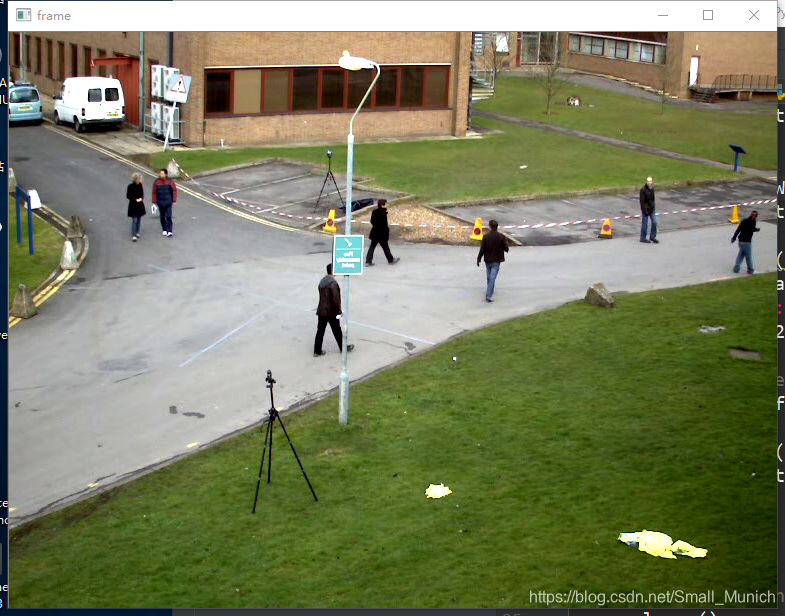视频读取接口VideoCapture类
Python调用VideoCapture类API接口:
'''
VideoCapture(params) :
0 为计算机默认摄像头 1 为自定义的视频文件或摄像头来源
'''
cap = cv2.VideoCapture(params)
我们知道Python调用底层C++的VideoCapture类API接口,下面我们在OpenCV源码中videoio.hpp查看一下VideoCapture类的声明:
VideoCapture类构造函数(c/c++两种):
C_API VideoCapture::VideoCapture();
C++_API VideoCapture::VideoCapture(const String& filename, int apiPreference = CAP_ANY);
C++_API VideoCapture::VideoCapture(int index, int apiPreference = CAP_ANY);
参数解释:
filename : 图像序列或者视频连接URL地址或者视频的路径;
index : 打开设备ID号(下面会有ID号解释);
apiPreference : VideoCapture API backends identifier,默认CAP_ANY;
附1:(为apiPreference 接口的设备ID对应)
enum VideoCaptureAPIs {
CAP_ANY = 0, //!< Auto detect == 0
CAP_VFW = 200, //!< Video For Windows (platform native)
CAP_V4L = 200, //!< V4L/V4L2 capturing support via libv4l
CAP_V4L2 = CAP_V4L, //!< Same as CAP_V4L
CAP_FIREWIRE = 300, //!< IEEE 1394 drivers
CAP_FIREWARE = CAP_FIREWIRE, //!< Same as CAP_FIREWIRE
CAP_IEEE1394 = CAP_FIREWIRE, //!< Same as CAP_FIREWIRE
CAP_DC1394 = CAP_FIREWIRE, //!< Same as CAP_FIREWIRE
CAP_CMU1394 = CAP_FIREWIRE, //!< Same as CAP_FIREWIRE
CAP_QT = 500, //!< QuickTime
CAP_UNICAP = 600, //!< Unicap drivers
CAP_DSHOW = 700, //!< DirectShow (via videoInput)
CAP_PVAPI = 800, //!< PvAPI, Prosilica GigE SDK
CAP_OPENNI = 900, //!< OpenNI (for Kinect)
CAP_OPENNI_ASUS = 910, //!< OpenNI (for Asus Xtion)
CAP_ANDROID = 1000, //!< Android - not used
CAP_XIAPI = 1100, //!< XIMEA Camera API
CAP_AVFOUNDATION = 1200, //!< AVFoundation framework for iOS (OS X Lion will have the same API)
CAP_GIGANETIX = 1300, //!< Smartek Giganetix GigEVisionSDK
CAP_MSMF = 1400, //!< Microsoft Media Foundation (via videoInput)
CAP_WINRT = 1410, //!< Microsoft Windows Runtime using Media Foundation
CAP_INTELPERC = 1500, //!< Intel Perceptual Computing SDK
CAP_OPENNI2 = 1600, //!< OpenNI2 (for Kinect)
CAP_OPENNI2_ASUS = 1610, //!< OpenNI2 (for Asus Xtion and Occipital Structure sensors)
CAP_GPHOTO2 = 1700, //!< gPhoto2 connection
CAP_GSTREAMER = 1800, //!< GStreamer
CAP_FFMPEG = 1900, //!< Open and record video file or stream using the FFMPEG library
CAP_IMAGES = 2000, //!< OpenCV Image Sequence (e.g. img_%02d.jpg)
CAP_ARAVIS = 2100, //!< Aravis SDK
CAP_OPENCV_MJPEG = 2200, //!< Built-in OpenCV MotionJPEG codec
CAP_INTEL_MFX = 2300, //!< Intel MediaSDK
CAP_XINE = 2400, //!< XINE engine (Linux)
};
VideoCapture类open函数:
virtual bool VideoCapture::open(const String& filename, int apiPreference = CAP_ANY);
virtual bool VideoCapture::open(int index, int apiPreference = CAP_ANY);
参数解释:同VideoCapture()构造函数一致;
调用方式只是先声明VideoCapture类对象,然后调用open函数;
cap = cv2.VideoCapture()
cap.open("fruit.avi")
直接使用构造函数方式:
cap = cv2.VideoCapture("fruit.avi")
VideoCapture::isOpened() 判断设备或视频文件是否成功打开,打开true,失败为false:
virtual bool VideoCapture::isOpened() const;
VideoCapture::release() 关闭设备或视频流文件,成功返回true,失败返回false;
virtual void VideoCapture::release();
VideoCapture::grab() 从设备或者视频流文件中抓取下一帧图片,抓取成功返回true,抓取失败返回false;
virtual bool VideoCapture::grab();
VideoCapture::retrieve() 解码并且返回刚刚抓取的视频帧,假设没有捕获视频帧将会返回false;
virtual bool VideoCapture::retrieve(OutputArray image, int flag = 0);
VideoCapture::read()该函数通过结果VideoCapture::grab()或者VideoCapture::retrieve()其中一个函数一起调用,用在捕获或解码和返回下一帧视频帧,假设没有捕获视频帧将会返回false;
virtual VideoCapture& operator >> (CV_OUT Mat& image);
virtual VideoCapture& operator >> (CV_OUT UMat& image);
virtual bool VideoCapture::read(OutputArray image);
获取视频帧的多种方式:
# methods 1
cap.read(frame)
# methods 2
cap.grab()
# methods 3
cap.retrieve(frame)
# methods 4
cap >> frame
VideoCapture::set()为设置视频流属性,VideoCapture::get()为获取视频流的属性;
virtual bool VideoCapture::set(int propId, double value);
virtual double VideoCapture::get(int propId) const;
参数解释:
propId 为属性的ID;
value 为属性ID对应要设置的值;
其中,枚举VideoCaptureProperties 使用最多的几个ID属性分别为:
CAP_PROP_POS_MSEC // 视频当前位置(毫秒)
CAP_PROP_POS_FRAMES // 视频当前位置(帧)
CAP_PROP_FRAME_WIDTH // 视频帧的宽度
CAP_PROP_FRAME_HEIGHT // 视频帧的高度
CAP_PROP_FPS // 视频流速率(帧率 帧/秒)
CAP_PROP_FOURCC // 视频流编码格式(四字符编码)
CAP_PROP_FRAME_COUNT // 视频流总帧数统计
附2 下面是属性ID所有参数:
enum VideoCaptureProperties {
CAP_PROP_POS_MSEC =0, //!< Current position of the video file in milliseconds.
CAP_PROP_POS_FRAMES =1, //!< 0-based index of the frame to be decoded/captured next.
CAP_PROP_POS_AVI_RATIO =2, //!< Relative position of the video file: 0=start of the film, 1=end of the film.
CAP_PROP_FRAME_WIDTH =3, //!< Width of the frames in the video stream.
CAP_PROP_FRAME_HEIGHT =4, //!< Height of the frames in the video stream.
CAP_PROP_FPS =5, //!< Frame rate.
CAP_PROP_FOURCC =6, //!< 4-character code of codec. see VideoWriter::fourcc .
CAP_PROP_FRAME_COUNT =7, //!< Number of frames in the video file.
CAP_PROP_FORMAT =8, //!< Format of the %Mat objects returned by VideoCapture::retrieve().
CAP_PROP_MODE =9, //!< Backend-specific value indicating the current capture mode.
CAP_PROP_BRIGHTNESS =10, //!< Brightness of the image (only for those cameras that support).
CAP_PROP_CONTRAST =11, //!< Contrast of the image (only for cameras).
CAP_PROP_SATURATION =12, //!< Saturation of the image (only for cameras).
CAP_PROP_HUE =13, //!< Hue of the image (only for cameras).
CAP_PROP_GAIN =14, //!< Gain of the image (only for those cameras that support).
CAP_PROP_EXPOSURE =15, //!< Exposure (only for those cameras that support).
CAP_PROP_CONVERT_RGB =16, //!< Boolean flags indicating whether images should be converted to RGB.
CAP_PROP_WHITE_BALANCE_BLUE_U =17, //!< Currently unsupported.
CAP_PROP_RECTIFICATION =18, //!< Rectification flag for stereo cameras (note: only supported by DC1394 v 2.x backend currently).
CAP_PROP_MONOCHROME =19,
CAP_PROP_SHARPNESS =20,
CAP_PROP_AUTO_EXPOSURE =21, //!< DC1394: exposure control done by camera, user can adjust reference level using this feature.
CAP_PROP_GAMMA =22,
CAP_PROP_TEMPERATURE =23,
CAP_PROP_TRIGGER =24,
CAP_PROP_TRIGGER_DELAY =25,
CAP_PROP_WHITE_BALANCE_RED_V =26,
CAP_PROP_ZOOM =27,
CAP_PROP_FOCUS =28,
CAP_PROP_GUID =29,
CAP_PROP_ISO_SPEED =30,
CAP_PROP_BACKLIGHT =32,
CAP_PROP_PAN =33,
CAP_PROP_TILT =34,
CAP_PROP_ROLL =35,
CAP_PROP_IRIS =36,
CAP_PROP_SETTINGS =37, //!< Pop up video/camera filter dialog (note: only supported by DSHOW backend currently. The property value is ignored)
CAP_PROP_BUFFERSIZE =38,
CAP_PROP_AUTOFOCUS =39,
CAP_PROP_SAR_NUM =40, //!< Sample aspect ratio: num/den (num)
CAP_PROP_SAR_DEN =41, //!< Sample aspect ratio: num/den (den)
CAP_PROP_BACKEND =42, //!< current backend (enum VideoCaptureAPIs). Read-only property
#ifndef CV_DOXYGEN
CV__CAP_PROP_LATEST
#endif
};
示例代码:
# -*-coding: utf-8 -*-
import cv2
'''
VideoCapture(params) : 0 为计算机默认摄像头 1 为自定义的视频文件或摄像头来源
'''
# methods 1 : 打开视频方式1
cap = cv2.VideoCapture(0)
# methods 2 : 打开视频方式2
# cap = cv2.VideoCapture()
# cap.open("fruit.avi")
# 设置显示图像宽高
cap.set(3, 320)
cap.set(4, 240)
cap_prop_frame_count = cap.get(propId=7) # 视频流帧数统计
print(cap_prop_frame_count)
while(cap.isOpened()):
# Capture frame-by-frame
ret, frame = cap.read()
# cap_prop_pos_msec = cap.get(propId=0) # 视频当前位置(毫秒)
# cap_prop_pos_frames = cap.get(propId=1) # 视频当前位置(帧)
# print(cap_prop_pos_msec, cap_prop_pos_frames)
cap_prop_frame_width = cap.get(propId=3) # 视频流的宽度
cap_prop_frame_height = cap.get(propId=4) # 视频流的高度
print(cap_prop_frame_width, cap_prop_frame_height)
#
# cap_prop_fps = cap.get(propId=5) # 帧率(帧/秒)
# print(cap_prop_fps)
# our operations on the frame come here
gray = cv2.cvtColor(frame, cv2.COLOR_BGR2GRAY)
# display the resulting frame
cv2.imshow('frame', gray)
if cv2.waitKey(1) & 0xFF == ord('q'):
break
# when everything is done, release the capture
cap.release()
cv2.destroyAllWindows()
视频保存接口VideoWriter类
VideoWriter类C++构造函数:
C_API VideoWriter:: VideoWriter()
C++_API VideoWriter::VideoWriter(const String& filename, int fourcc, double fps,
Size frameSize, bool isColor = true);
C++_API VideoWriter:: VideoWriter(const String& filename, int apiPreference,
int fourcc, double fps,Size frameSize, bool isColor = true);
参数解释:
filename: 保存写入视频流文件名;
fourcc: 编码四字符格式,MJPEG、XVID等等;
fps: 保存的帧率;
frameSize: 保存视频帧大小,(width, height);
isColor:非0时,期望是对彩色图像编码,为0时是对灰度图像进行编码;目前只支持在windows平台操作;
apiPreference:The apiPreference parameter allows to specify API backends to use. Can be used to enforce a specific reader implementation if multiple are available: e.g. cv::CAP_FFMPEG or cv::CAP_GSTREAMER.
初始化VideoWriter类时候,先声明编码保存方式:
fourcc = cv2.VideoWriter_fourcc(*'XVID')
out = cv2.VideoWriter('output.avi', fourcc, 20.0, (640, 480), True)
FourCC编码方式如下图所示

VideoWriter::open()函数:
virtual bool VideoWriter::open(const String& filename, int fourcc, double fps,
Size frameSize, bool isColor = true);
bool VideoWriter::open(const String& filename, int apiPreference, int fourcc,
double fps, Size frameSize, bool isColor = true);
参数解释:
filename 视频文件名;
fourcc: 编码格式;
fps: 帧率;
frameSize: 视频帧的宽高;
isColor: 是否采取彩色编码;
判断VideoWriter::isOpened()是否成功初始化
virtual bool VideoWriter::isOpened() const;
VideoWriter::release()关闭视频流写入文件
virtual void VideoWriter::release();
VideoWriter::write()视频帧写入文件函数:
virtual VideoWriter& operator << (const UMat& image);
virtual VideoWriter& operator << (const Mat& image);
virtual void VideoWriter::write(InputArray image);
VideoWriter::set()与VideoWriter::get()函数意义:
VideoCapture::set()与VideoCapture::get()一致,参数解释参考VideoCapture;
virtual bool VideoWriter::set(int propId, double value);
virtual double VideoWriter::get(int propId) const;
示例代码:
# -*- coding: utf-8 -*-
import cv2
cap = cv2.VideoCapture(0)
# Define the codec and create VideoWriter object
fourcc = cv2.VideoWriter_fourcc(*'MJPG')
out = cv2.VideoWriter('output.avi', fourcc, 20.0, (640, 480), True)
while(cap.isOpened()):
ret, frame = cap.read()
if ret == True:
frame = cv2.flip(frame, 1) # 水平反转
# write the flipped frame
out.write(frame)
cv2.imshow('frame', frame)
if cv2.waitKey(1) & 0xFF == ord('q'):
break
else:
break
# Release everything if job is finished
cap.release()
out.release()
cv2.destroyAllWindows()
显示一帧图像:


原始视频流帧宽高为768x576,我们写入视频保存帧宽高为640x480。所以,展示图像帧率会有宽高比不一致的情况。








 本文介绍OpenCV中的VideoCapture和VideoWriter类使用方法,包括视频读取、保存接口及属性设置等,并提供示例代码。
本文介绍OpenCV中的VideoCapture和VideoWriter类使用方法,包括视频读取、保存接口及属性设置等,并提供示例代码。
















 25万+
25万+

 被折叠的 条评论
为什么被折叠?
被折叠的 条评论
为什么被折叠?








